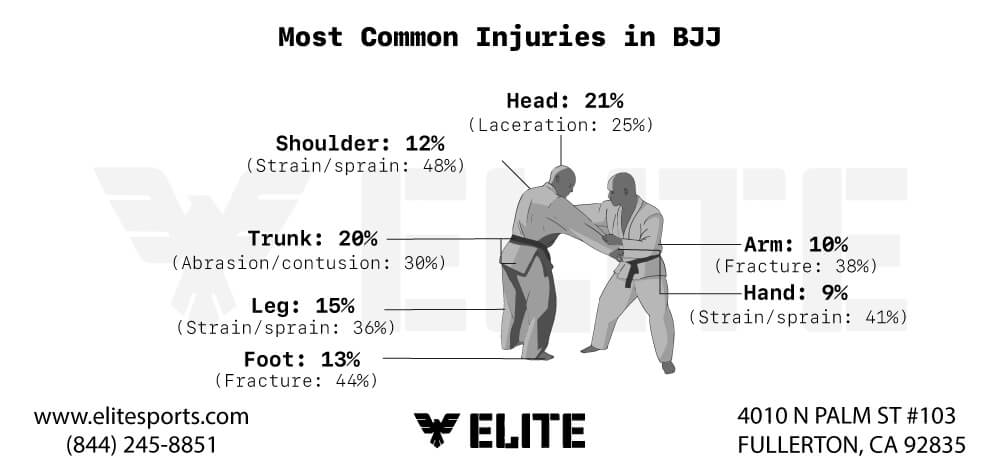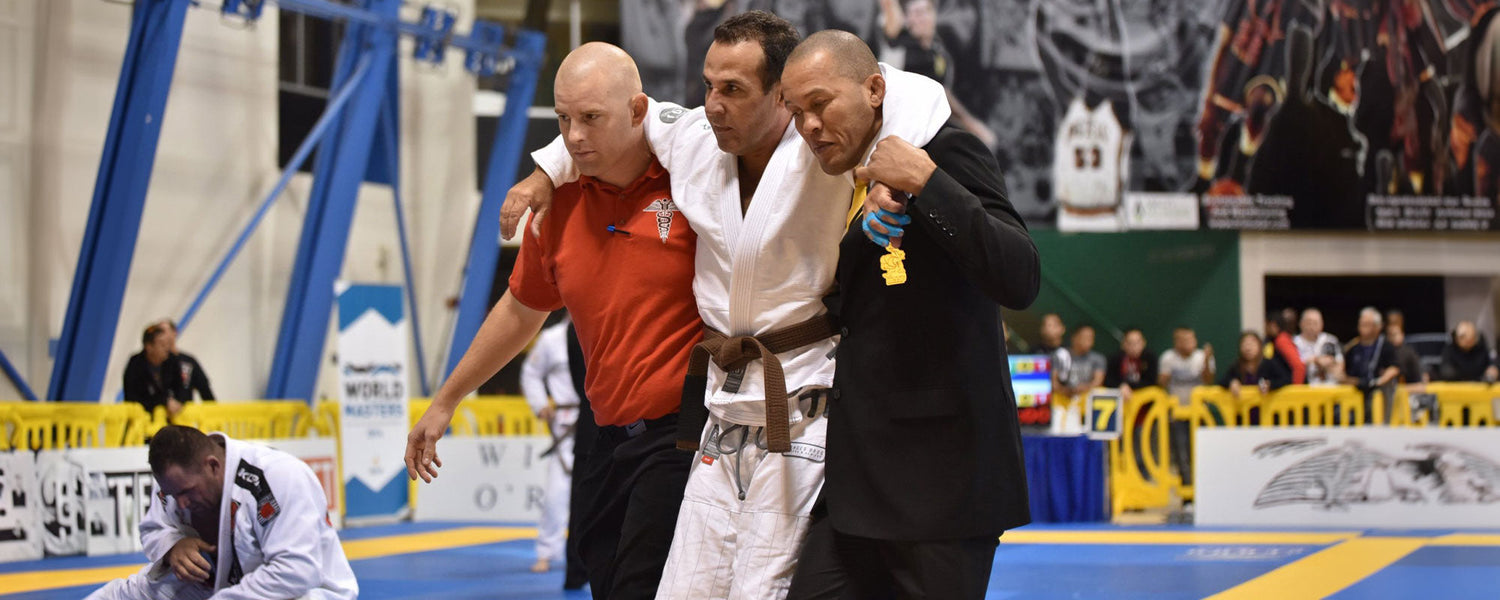Table of content
Let's start with facts. Even the most advanced Brazilian Jiu-Jitsu practitioners can get hurt from time to time, and no one is safe from the risk of an injury when they train this frequently and with intensity. But you can minimize the possibility of a potential injury by taking all the precautionary measures that you can. It’s important to remember that every training session is an opportunity for growth. The goal is to make every session a learning experience by pushing the limits and going through the practices again and again until they become muscle memory. When you deal with an injury, it can feel like things have gone off track. Injuries can force you into a corner mentally, challenging your determination and dedication.
When you first start BJJ it seems as though everyone you roll with is some kind of a superhuman that can’t get hurt. It was because they trained their body to withstand pressure and grappling moves for building stamina to face the opponent on the mat. This is the primary purpose of sparring and rolling apart from sharpening techniques. It’s not until you get your first couple of bruises and nasty sprains then the harsh aspect of training became your reality. . The black belts are the ones who have put in the most time and effort – but that doesn’t mean your white belt friends aren’t dedicated or committed. They just have different priorities, which might make their training more sporadic than yours.
When you train regularly, it’s inevitable that at some point you are going to pick up an injury. Because you have to push your limits to the extent that your opponent can't do it for you. While practicing your techniques to master each and every move and position. The good news is that almost every BJJ practitioner has dealt with this before, and it doesn’t have to be the end of your journey. You just need to know how to deal with the injury in the best way so that it doesn’t stop you from training again in the future.
1. Most Common Injuries in BJJ
Brazilian jiu-jitsu involves swift and fluid chest-to-chest movements while using all limbs for strangling the opponent and defending against the attacks at the same time. According to the collected data, most BJJ injuries occur in the neck, head, and knee parts. Furthermore, early signs of any injury must be taken seriously because they have the potential to become a serious issue if not taken care of professionally Injury prevention is an essential topic that should be taught in all the BJJ academies. In which the potential injuries and their causes are explained at length with precautionary measures to avoid them. However, there are some injuries that can only be prevented by early tapping, and tapping out from a fight is something that every fighter is prone to resist. In the situations of armbar, triangle choke, rear naked choke, and guillotine choke, it is always advised to tap out if the opponent has you in a firm grip otherwise the chances of serious injury are very high.
Rener Gracie had agony in his leg after combat and he took it with an adjacent quadricep injury. Later on, it is disclosed that he has a hernia in the spine that led him to surgery. To start over again took almost 10 months. Sometimes BJJ injuries are not physique injuries, it turns into nerve injuries that hurt a lot; nerve injury must be dealt with under the supervision of a specialist. Even though it is challenging to predict their injury after intense combat, you can look for early symptoms. Some common injuries are knee tear, sprains, shoulder trauma, muscle jamming, and broken fingers or toes. Other severe injuries included hyperextended elbow and knee, damaged ribs, broken ankles, neck and back pain, and of course cauliflower ear.

1.1. Neck Injuries
Addressing neck injuries in BJJ can vary on the performance, strength, and flexibility of a fighter. Because of the delicate structure of the neck, it gives mobility to our head. But in the situation of headlocks, there are high chances of neck injuries. Any problem or numbness in the upper shoulder area, arms, or knees should be taken very seriously because these areas are linked with neck injuries.
How to deal:
- First, identify the area of pain, and notice the symptoms. Don’t hesitate to see a doctor if you are suffering from chronic pain, numbness, excruciating headaches, and blurry vision because these are serious symptoms and can cause damage if not taken seriously.
- Try to mobilize the neck as often as you can. Do not let it rest in one posture. Keep it moving.
- f you are training in jiu-jitsu, try to stretch your neck muscles if you don’t have intense pain. There are specific exercises and tools available to avoid neck injuries by strengthening the neck muscles.
- Yes, you can continue your BJJ sparring and roll if you don't have a serious injury. It is advised that you should spare and grapple with a trusted partner and avoid any position that involves putting pressure on the shoulders, neck, or head.
- Avoid rolling in jiu Jitsu training, try to drill if the pain is bearable and there is some relief after stretching. Don’t give yourself a hard time.
- Restore function and try to come back to a normal routine, as it is part of recovery, but if the injury is serious, seek the advice of a specialist and religiously follow the suggestion of a medical officer.

1.2. Cauliflower Ear
BJJ fighters usually have big knots around their ears because of extensive wrestling or rolling. The cauliflower ear is a badge of honor for athletes and a symbol of high-level grapplers. During combat it happens due to extensive trauma to the ears, hematoma builds in the ear skin causing the lump around the ear. Blood circulation eventually causes clots and lumps which will fill the damaged area of the ear. BJJ players usually develop a cauliflower ear if they are doing a lot of wrestling and getting their heads ripped guillotines. Accidental elbow or knee to ear while rolling let that area swell and become a cause of cauliflower ear.
How to deal:
- If you're feeling swelling or pain in your ear and suspect that you have a little cauliflower ear start applying ice, it will reduce swelling.
- Take a pain killer.
- Try the magnet technique to prevent cauliflower ear.
- Utilize some money to buy headgear for the prevention of cauliflower ear. Only a complete way to avoid cauliflower ear is to wear headgear from the start of rolling and wrestling.
Also read: 5 Most Common BJJ Injuries That You May Face

1.3. Back Pain
Back injuries or pain in BJJ are not as common as neck pains or injuries. Avoid such positions that can disturb the natural posture, they can cause trouble for your back. Back pain is also caused by guillotines and headlocks. Upper or Lower back pain can be caused by intense rolling with an opponent. Some back pains are common in BJJ combat training:
Herniated disc: It occurs when the crack pushes the nerve in the annulus, Herniated disc gets active in BJJ when you are intensely rolling with an opponent or partner.
Spinal cord: This pain or injury can occur during the mount position. Rener Gracie said that lower back pain or injuries can happen to the bottom fighter in the intense grappling of the full guard position.
Ligament injury: This injury can occur when the opponent has extensive pressure placed on the joint that results in tearing inner tissues and leads to severe pain. This injury can happen in butterfly guard and lasso guard positions.
How to deal:
- Stop fighting and rolling for at least recover the injury.
- Apply the ice to injured areas.
- Take the counter pain reliever to reduce the pain.
- Change your sleeping position to recover the back sprains for at least 2 weeks.
- If nothing works and you have acute pain, don’t waste time and go to a specialist for diagnostic and then recovery treatment.
Also read: Rib Injuries In Brazilian Jiu-Jitsu

1.4. Shoulder Pain
It involves the inability to move your shoulder and pinning shivers of pain in the shoulders and lower neck area. If your shoulder area is swelling, you are unable to move the shoulder and experiencing acute pain which means there is a tear in the supraspinatus tendon. Shoulder injuries can happen when you are dealing with open elbows. If your opponent locks your arms then the risk of shoulder injury increases. If you resist and pull your shoulder in the shoulder lock and the opponent enhances pressure and you choose to resist instead of tapping out it can cause a serious injury.
How to deal:
- Apply ice on the affected shoulder area for 15 minutes.
- Stop training with your affected shoulder, try to rest your shoulder for 3 days.
- Intake prescribed medicine to reduce inflammation and pain.
- Go to the specialist doctor if you are facing symptoms like shudders, extensive swelling, increasing pain, and inability to move the arm.

2. How To Deal With Injury In BJJ: A Guide For Newcomers
2.1. Take Time to Recover
The most important part of dealing with any injury is the recovery process to reduce the risk of re-injury. This means avoiding the urge to rush back into training before your body is completely healed. It can be difficult to sit on the sidelines when your teammates are rolling, but it’s important to give your body recovery time. The best thing you can do for yourself is to follow your doctor’s recommendations. Don’t try to be tough, you will only end up making your injury even worse. Also, try not to let your ego get in the way. It’s important to remember that you don’t have to be at 100% to start training again. In fact, it’s far better to ease yourself back into BJJ after healing rather than diving back to training when you’ve just started to feel better.
2.2. Change your routine
When you are injured, you have a great opportunity to change your routine. This is particularly helpful and necessary if you are dealing with a recurring injury. Without an excessive training routine, you can learn and master simple yet new techniques, try out new drills, and get creative with your BJJ routine. This way, your body is still getting something out of your training sessions and you are not letting your injury hold you back. se this recovery time as an opportunity to focus on other aspects of your game and develop them further. Moreover, a BJJ practitioner should be able to come back to regular routine with high confidence and a sense of triumph when they are fully healed and ready to go again.
Also read: Steps to Return to BJJ After A Knee Injury
2.3. Focus on Flexibility and Mobility
When a BJJ athlete is injured, he has plenty of time to focus on his weak areas with light training without involving the injured part of the body. The most beneficial strategy for keeping your mind occupied is to focus on the techniques of injury prevention.
These are the workouts that you can do in recovering process, the frog stretch, knee-to-elbow stretch, and the psoas stretch. However, you can add BJJ squat and ankle mobility drills. It’s important to remember that you don’t want to focus too much on your injury when you’re stretching and doing mobility work. Always remember that your primary purpose to train in the recovery process is to keep the body and muscles moving and active. You need to ensure that you’re staying mobile and flexible throughout the training session. Not only will this assist your BJJ, but it can also help to prevent other injuries in the future
2.4. Learn New Techniques While Recovering From BJJ Injuries
Usually, it is common to have bruises and sprain injuries when you are rolling and sparring. Most sprain and injuries can be treated with initial medications at home while resting. Make yourself busy with yoga and stretching, if you are sidelined with regular BJJ practice, this will allow you to keep yourself active and maintain body mobility.
Furthermore, don’t fall into the trap of watching hours-long BJJ videos. it's important to focus on techniques that are basic yet effective and essential to every level. However, following a diverse spectrum (Yoga and pain relief stretching) to challenge yourself and stay motivated during the recovery process. Also, a remarkable approach to accelerate your progress and get back to training sooner than you would have otherwise.
2.5. Don't Be Afraid to Ask For Help
While there is no special formula, when you’re injured and trying to find your way back to training, taking time and rest can make you frustrated and demotivated. During This specific leisure time, recovery could be challenging if you’re injured and competing at the same time. If you have a serious injury, pause every major training and competition. You need to give your dedicated time, energy, and attention to the recovery process. Put yourself in a position where you can ask for help.
In fact, it’s important to surround yourself with teammates who are willing to motivate and help you through the process and support you along the way. Additionally, spending quality time with fellow mates allows you to be engaged and productive. BJJ is a team sport, and it’s important that you don’t let your injury hold you back. Therefore, the important thing to remember is, that you can still help your team to succeed, and still learn and grow with the recovery process. Stay positive, and don’t be afraid to reach out when you need help.
3. Bottom Line to Deal with Injury in BJJ
Injuries happen in all combat sports, and they’re almost inevitable when you train as often as a pro fighter does. The important thing is to use this time as an opportunity to grow and improve both mentally and physically. Spend some quality time with family and friends. When you’re injured, remember that recovery is the most important part, and always follow your doctor’s recommendations for treatment.
Nevertheless, in sports everyone suffers from this trauma. In addition, it’s important to change up your routine, focus on flexibility and mobility, and learn new techniques while you’re out.
Photo Credit: @sjjarousehill











Leave a comment
This site is protected by hCaptcha and the hCaptcha Privacy Policy and Terms of Service apply.